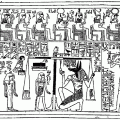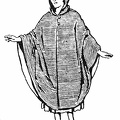Shape. This garment varied in width across the shoulders. The
greater the distance between the neck-hole and the edge of the top
corner (see A B), the more the upper arm was hidden. This has the misleading effect of a sleeve to the elbow.
The Romans had a great aversion to anything in the nature of a close arm covering, so the fashion of wearing long shaped separate sleeves, set by
Alexander the Great, was not followed at Rome, as it was considered unmanly; besides, such sleeves were worn by foreigners and barbarians, so naturally this mode was distasteful to the patriotic intolerance
of a Roman citizen.
The Greek " kolobus," called by the Romans the "colobium." Another name for this garment was the "tunica". When more than one was worn, the under ones were called the "tunica interior" or "subucula." A long tunica was called "tunica talaris."
- Auteur
- Costume and Fashion
The evolution of European dress through the earlier ages
By Herbert Norris
Published in 1924
Available at archive.org - Ajoutée le
- Dimanche 15 Novembre 2020
- Dimensions
- 641*914
- Albums
- Visites
- 2126
- Téléchargements
- 50
 Télécharger la photo
Télécharger la photo





